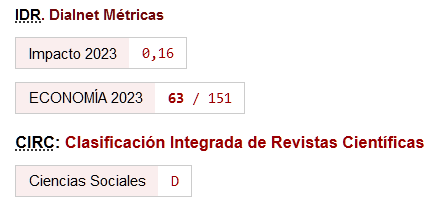La privatización de la ciencia y el conocimiento. El cercamiento de los bienes comunes. Las patentes en biotecnología: el caso de las secuencias genéticas
Palabras clave:
concepto de bien público, información, conocimiento como recurso de propirdad común, patentesResumen
La privatización de áreas insospechadas del patrimonio colectivo de la humanidad ha adquirido en los últimos años carta de naturaleza. Uno de los instrumentos principales para abrir el sendero y legitimar dicha privatización son las patentes. El análisis de estas entidades legales se tropieza, sin embargo, con su interdisciplinariedad. En las patentes confluyen tres espacios: la economía, las leyes y la tecnología. El espíritu que anima este trabajo es construir un puente entre estos espacios. Por esta razón, el trabajo está claramente diferenciado en dos partes. En la primera, se examina la noción de información como bien público y se efectúa un análisis del concepto de propiedad en economía, que constituyen las categorías que sirven de anclaje para la exposición de la segunda parte. Esta última está dedicada a las patentes como entidades legales y expone los requisitos legales que debe cumplir una invención para su patentabilidad y los problemas que presenta la aplicación de estos requisitos y principios en el sector de la biotecnología. El mensaje central de este trabajo tiene una doble dimensión. Por una parte, se señala la importancia que tiene, en los momentos actuales, preservar las características del conocimiento como un recurso de propiedad común; y, por otra, intentamos mostrar la necesidad de ampliar, en unos casos y erradicar en otros, la visión que lleva a suponer que todas las interacciones humanas pueden ser modelizadas como intercambios de mercado.
Descargas
Citas
ADLER, R.G. (1992): "Genome Research: Fulfilling the Public's Expectations for Knowledge and Commercialization", Science, August, vol. 257, 908-914. https://doi.org/10.1126/science.1502557
AGNEW, B. (2000): "Financial conflicts get more scrutiny in clinical trials", Science, 289, 1266-1267.
https://doi.org/10.1126/science.289.5483.1266
ALLEN, R.C. (1999): "Tracking the agricultural revolution in England". Economic History Review, 52(2), 209-235. https://doi.org/10.1111/1468-0289.00123
ALLEN, R.C. (2001): Revolución en los campos: La reinterpretación de la Revolución Agrícola Inglesa. Versión Castellana de C. Abadía. Universidad Pompeu Fabra. Conferencia inaugural del X Congreso de Historia Agraria. Sitges.
ARROW, K.J. (1962): "Economic welfare and the allocation of resources for invention" en Lamberton, D.M. (ed.): Economics of information and knowledge, Bungay, Suffolk. Penguin Education, 1971, 141-159.
ARUNDEL, A. (2000): "Patents - the Viagra of innovation policy?", Internal report to the expert group, Merit.
AYERS, P.J. (1999): "Armed and Ready: Defeating Patent Infringement Claims by Summary Judgment", Journal of the Patent and Trade Mark Office, June, 421-449.
BALTER, M. (2000): "France rebels against gene-patenting law", Science, 288, 2115.
https://doi.org/10.1126/science.288.5474.2115a
BARLOW, J. P. (1998): "Vender Vino", El paseante, la revolución digital y sus dilemas, 27-28.
BARTON, J.H. (1991): "Patenting Life", Scientific American, March, vol. 264(3), 18-24.
https://doi.org/10.1038/scientificamerican0391-40
BARTON, J.H. (1995): "Patent Scope in Biotechnology", The International Review of Industrial Property Right and Copyright Law (IIC) , vol. 26(5), 605-618.
BEIER, F.K. (1986): "The inventive step in its historical development", IIC, Vol. 26, nº 5, 605-618.
BERCOVITZ RODRÍGUEZ-CANO, A. (1994): "La Ley Española de Patentes", en Centro de Estudios para el Fomento de la Investigación (CEFI) Reflexiones sobre la protección de la investigación en el umbral del 2000, Barcelona. CEFI, 1994, 101-119.
BERRIER, E.F. (1996): "Global patent costs must be reduced", IDEA, vol. 36(4), 473-499.
BOLLIER, D. (2001): Public Assets, Private Profits. New American Foundation. Washington. www.newamerica.net/events/transcript texts/PA Report
BOYLE, J. (1992): "A theory of law and information: copyright, spleens, blackmail and insider trading", California Law Review, 87, 1413-1490. https://doi.org/10.2307/3480824
BOYLE, J. (1996): Shamans, software & spleens. Law and the construction of the information society, Harvard University Press. https://doi.org/10.4159/9780674028630
BOYLE, J. (1997): "A politics of Intellectual Property: Environmentalism For the Net?", Duke Law Journal, 87, 87-102. https://doi.org/10.2307/1372861
BUCHANAN, J.M. (1987): "The Constitution of Economic Policy", American Economic Review, Vol.77, 243-250.
CAMBROSIO, A., P. KEATING AND M. MACKENZIE (1990): "Scientific Practice in the Courtroom: the Construction of Sociotechnical Identities in a Biotechnology Patent Dispute", Social Problems, vol. 37(3), 275-293. https://doi.org/10.1525/sp.1990.37.3.03a00010
COHENDET, P., MEYER-KRAHMER, F. (2001): "The Theoretical And Policy implications of knowledge Codification", Research Policy 30, 1563-1591. https://doi.org/10.1016/S0048-7333(01)00168-8
COOPER, C.C. (1991): "Social Construction of invention through patent management: Thomas Blanchard's Woodworking Machinery", Technology and Culture, vol. 32(4), 960-998. https://doi.org/10.1353/tech.1991.0005
CORNISH, W. (1996): Intellectual property: patents, copyright, trade marks and allied rights, Sweet & Maxwell.
CRESPI, S. (1995): "Biotechnology Patenting: The Wicked Animal Must Defend Itself", EIPR, 9, 431-441.
DASGUPTA, P. (1987): "The Economic Theory of Technology Policy", en P. Dasgupta y P. Stoneman, ed, Economic Policy and Technological Performance, Cambridge University Press. https://doi.org/10.1017/CBO9780511559938
DAVID. P.A. (1993): Knowledge, Property, and the Systems Dynamics of Technological Change, Proceedings of the World Bank Annual Conference on Developments Economics 1992. Washington. The World Bank. https://doi.org/10.1093/wber/6.suppl_1.215
DEMSETZ, H. (1967): "Toward a theory of property rights", American Economic Review, vol. LVII (2), 347-359.
DICKINSON, Q. (2000): "Commissioner's Page", March, Patent and Trademark Office Today, 2-4.
DÍEZ-PICAZO L Y GUILLÓN, A. (2001): Sistema de derecho civil. Vol.3, Editorial Tecnos.
DOSI, G. (1982): "Technological paradigms and technological trajectories: A suggested interpretation of the determinants and directions of technical change". Research Policy,11, 147-162. https://doi.org/10.1016/0048-7333(82)90016-6
DRAHOS, P.A (1996): Philosophy of intellectual property, Dartmouth Publishing Company Limited, England.
DRAHOS, P.A. (1999): "Biotechnology Patents, Markets and Morality", European Intellectual Property Review 9, 441-449.
EUROPEAN PATENT OFFICE (2000): Annual Report.
EUROPEAN PATENT OFFICE (2000): Guidelines for Substantive Examination, Accessible en www:european-patent-office.org.
DRAHOS, P.A. CON BRAITHWAITE, J. (2002): Information Feudalism. Who owns the Knowledge Economy. Earthscan.
FRANZOSI, M Y DE SANCTIS (1995): "Moral Rights and New Technology: are Copyright and Patents Converging?", European Intellectual Property Review 2, 63-66.
FURUBOTN, E. Y G. PEJOVICH (1972): "Property Rights and Economic Theory: A Survey of Recent Literature", Journal of Economic Literature Vol.10,1137-1162.
GOLDBERG, V.P. (1974): "Public Choice-Property Right", Journal of Economics Issues 8(3), 555-579.
https://doi.org/10.1080/00213624.1974.11503208
GRINDLEY, P.C. Y D.J. TEECE (1997): "Managing Intellectual Capital: Licensing and Cross-licensing in semiconductors and electronics", California Management Review, Winter, vol.39(2), 3-41.
https://doi.org/10.2307/41165885
HARDIN, G. (1998): "Extensions of "The Tragedy of the Commons" ", Science, vol. 280, 682-683.
https://doi.org/10.1126/science.280.5364.682
HELLER, M.A. AND R.S. EISENBERG (1998): "Can Patents Deter Innovation? The Anticommons in Biomedical Research", Science, vol. 280, 98-701. https://doi.org/10.1126/science.280.5364.698
HELLER, M.A. (1998): "The tragedy of the anticommons: property in the transition from Marx to Markets". Harvard Law Review, vol.111, nº3, 621-688. https://doi.org/10.2307/1342203
IGLESIAS PRADA, J.L. (1995): La Proteccion Jurídica de los Descubrimientos Genéticos y el Proyecto Genoma Humano. Madrid. Civitas.
INFORME DE DESARROLLO HUMANO (1999), Editorial Mundi-prensa.
ISIS (2003): Canada Rejects Patents on Higher Live Forms, www.i-sis.org.uk.
KAPLINSKY, R. (1992): "Derechos de propiedad industrial e intelectual a partir de la Ronda Uruguay en El Cambio Tecnológico hacia el nuevo milenio", Mikel Gómez Uranga. Miguel Sánchez Padrón y Enrique de la Puerta (comp.), Barcelona, Icaria.
KARNELL,G.W.G. (1995): "Protection of Results of Genetic Research by Copyright or designRights?" European Intellectual Property Review 8, 355-358.
LANGE, D. (1981): "Recognizing the public domain", Law and Contemporary Problems. Vol 44, No.4, 147-178. https://doi.org/10.2307/1191227
LESGARDS, R (1998): "Refundar el derecho de propiedad". Le Monde Diplomatique en español, Diciembre.
LESSIG, L. (2001): The Future of Ideas. Random House. New York.
LITMAN, J. (1990): "The Public Domain", Emory Law Journal, vol. 39(4), 965-1023.
MACHLUP, F. Y PENROSE, E. (1950): "The patent controversy in the Nineteenth century", The Journal of Economic History, vol. X, nº1, Mayo 1950. https://doi.org/10.1017/S0022050700055893
MACHLUP, F. (1958): An economic review of the patent system. Study nº 15. U.S. Senate.
MARX, K. (1967): El Capital. E.D.A.F.
MAYHEW, A. (1985): "Dangers in Using the Idea of Property Rights: Modern Property Rights Theory and the Neo-Classical Trap", Journal of Economic Issues XIX, 4, 959-966.
https://doi.org/10.1080/00213624.1985.11504447
MERGES, R.P. (1991): "A brief Note on Blocking Patents and Reverse Equivalents: Biotechnology as an Example", Journal of the Patent and Trade Mark Office November, 878-888.
NATURE (2000): "Bad clinical practices", Nature, vol. 405, 29 June, 981. https://doi.org/10.1038/35016694
NELSON, R. (1989): "What is private and what is public about technology", Science, Technology & Human Values, 14 (3), 229-241. https://doi.org/10.1177/016224398901400302
NORTH, D.C. (1994): "Economic performance through time", American Economic Review, 84(3), 359-368.
OVEJERO LUCAS, F: (2003): "Las Matemáticas de la Economía", Claves, nº136, 48-52.
RIFKIN, J. (1999): El siglo de la Biotecnología. Crítica-Marcombo.
RANDALL, A. (1978): "Property Institutions and Economic Behavior", Journal of Economics Issues, 12(1), 1-21. https://doi.org/10.1080/00213624.1978.11503502
ROMER, P.M. (1990): "Are nonconvexities important for understanding growth?", American Economic Association Papers and Proceedings, 80(2), 97-103. https://doi.org/10.3386/w3271
ROMER, O. (1993): "Implementing a National Technological Strategy with Self-Organizing Industry Investment Boards". Brookings Papers: Microeconomics 2, 345-399. https://doi.org/10.2307/2534742
ROSE, C. (1986): "The Comedy of the Commons: Custom, Commerce and Inherently Public Property", The University of Chicago Law Review, 53(3), 711-781. https://doi.org/10.2307/1599583
ROSENBERG, L. E. AND A.N. SCHECHTER (2000): "Gene Therapist, Heal Thyself?", Science, vol. 287, 1751. https://doi.org/10.1126/science.287.5459.1751
RYAN, A. (1991): "Property", The New Palgrave a Dictionary of Economics, MacMillan Press.
SÁNCHEZ, M., V. CANO AND E. LOS ARCOS (1996): "An analysis of EPO renewals: a first step towards patent value estimation. Some conceptual considerations", Paper presented in the 54th International Conference for the Applied Econometrics Association, Luxemburg, (Working Paper 98/99-03, La Laguna, 1999).
SÁNCHEZ, M. Y URANGA, M. (2001): "The institutional choice in biotechnology: Patents and ethics", Journal of Economics Issues, XXXV (2), 315-322.
SANTOS PASTOR (1989): "Formas de propiedad y análisis económico del derecho: ¿nuevas luces a viejas sombras", Economistas, nº 38, 28-31.
SCIENCE (2000): "Genetic Benefit Sharing", Science, Vol. 290,49. https://doi.org/10.1126/science.290.5489.49
SEN, A. (1976): "Rational fools: A critique of the behavioral foundations of economic theory", reproducido en Nueva Economía del Bienestar. Escritos Seleccionados, 1995. Universitat de Valencia.
SEN, A. (1980): "The impossibility of a paretian liberal" reproducido en Nueva Economía del Bienestar. Escritos Seleccionados, 1995,Universitat de Valencia.
SEN, A. (2000): Desarrollo y Libertad. Planeta.
SPECK, A. (1995): "Genetic Copyright. ?" European Intellectual Property Review 4,71-173.
SULSTON, J Y FERRY, G (2003): El Hilo Común de la Humanidad. Una historia la ciencia, la política, la ética y el genoma humano. Siglo XXI de España.
VENTER, J.C. (1995): "The patentability of genetic discoveries", The Human Genome Project: Legal Aspects, Volume II. Fundación BBV, 123-126.
WELLS, A.J. (1994): "Patenting New Life Forms: An Ecological Perspective", EIPR, 3, 111-118.
Descargas
Publicado
Cómo citar
Número
Sección
Licencia
Esta licencia permite a terceros compartir (copiar y redistribuir el material en cualquier medio o formato) y adaptar (remezclar, transformar y crear a partir del material para cualquier finalidad, incluso comercial), siempre que se reconozca la autoría y la primera publicación en esta revista (La Revista, DOI de la obra), se proporcione un enlace a la licencia y se indique si se han realizado cambios en la obra.







